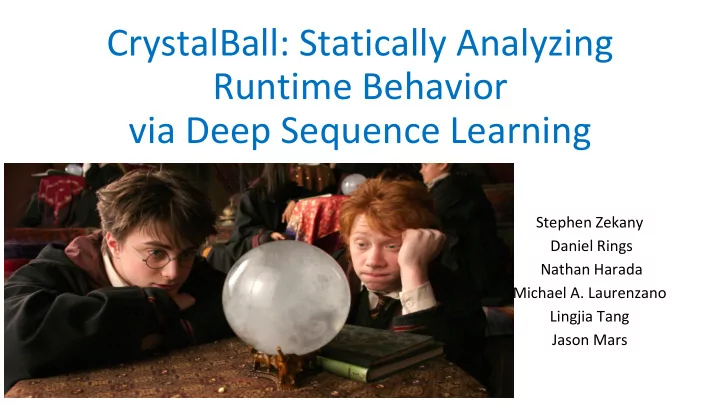

CrystalBall: Statically Analyzing Runtime Behavior via Deep Sequence Learning Stephen Zekany Daniel Rings Nathan Harada Michael A. Laurenzano Lingjia Tang Jason Mars
Introduction ➢ Why analyze runtime behavior? ➢ How to analyze it for software lifecycle? – Hot Paths (1 in a million) ➢ Path profiling: ➢ Dynamic Profiling: Digital Mars C++ ➢ Group functions that call each other ➢ Static Profiling: Predict runtime behavior before the program runs ➢ Applications - Branch Prediction, Trace formation, Basic Block placement optimization
Why not Dynamic Profiling? ➢ Needs representative production environment ➢ Computationally Expensive ➢ In for a penny, in for a pound
Static Profiling – CrystalBall ➢ Program behavior is latent within instructions ➢ Higher the quality of static analysis => better runtime prediction ➢ Can leverage large amount of data ➢ Language independent – uses Intermediate Representation (IR) ➢ IR – Semantic + Low - level Ops Compilers - GCC, LLVM (Low Level Virtual Machine) ➢ Sequence of blocks => use RNN
Intermediate Representation C++ Function - int mul_add(int x, int y, int z){ return x * y + z; } IR - define i32 @mul_add(i32 %x, i32 %y, i32 %z) { entry: %tmp = mul i32 %x, %y %tmp2 = add i32 %tmp, %z ret i32 %tmp2 }
Basic Block Enter Source Code: Basic Blocks: w = 0; w = 0; x = x + y; x = x + y; B1 B1 y = 0; y = 0; if ( x > z) if ( x > z) { y= x; y= x; x++; B2 B3 B2 x++; } else{ y = z; B3 y = z; z++; B4 z++; } B4 w = x + z; w = x + z; exit
Ball Larus Path Profiling ➢ Convert each function to Directed Acyclic Graph (DAG) ➢ Back edges are removed in DFS ➢ Unique sum of edge weight for a path
Performance Metrics Confusion Matrix: Predicted +ve -ve Actual +ve TP FN -ve FP TN ➢ Precision = TP/ (TP + FP) ➢ Recall = TP/(TP+FN) ➢ F1 – measure = 2 * Precision * Recall /(Precision + Recall)
Solution – AUROC (Area Under ROC) TPR (Recall) = TP/ (TP + FN) FPR = FP/(FP+TN) TPR = FPR (Random) More area => better classifier
Crystal Ball - Overview
Crystal Ball - Implementation ➢ Data Collection: Using Profiling Instrumentation ➢ Static Data Extraction ➢ Basic Block to feature vector ➢ Path Sampling – ➢ Include all Hot Paths ➢ Proportional Sampling for Cold paths ➢ Equal number of Cold paths for every function (2000) ➢ Training: leave-one-program-out
LSTM Architecture
Programs – SPEC CPU2006
Logistic regression - B&W static path classifier ➢ Removed Features specific to java code ➢ Added IR specific feature ➢ Hand crafted features ➢ One feature vector per path ➢ B& W model – 0.83 AUROC, Crystal Ball – 0.85
Results -
Future Work/Caveats ➢ Although AUROC is best among the shown measure, greater AUROC value doesn’t guarantee better model. ➢ Actual improvement in runtime behavior of a program? ➢ LSTM can just be used for feature extraction ➢ Novelty detection problem – SVM, K- Means ➢ Various Optimization flags and IR combination can be tried out.
Questions?
Recommend
More recommend